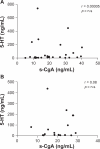Subjective food hypersensitivity: assessment of enterochromaffin cell markers in blood and gut lavage fluid
- PMID: 21887108
- PMCID: PMC3160864
- DOI: 10.2147/IJGM.S18349
Subjective food hypersensitivity: assessment of enterochromaffin cell markers in blood and gut lavage fluid
Abstract
Background: Food hypersensitivity is commonly suspected, but seldom verified. Patients with subjective food hypersensitivity suffer from both intestinal and extraintestinal health complaints. Abnormalities of the enterochromaffin cells may play a role in the pathogenesis. The aim of this study was to investigate enterochromaffin cell function in patients with subjective food hypersensitivity by measuring serum chromogranin A (CgA) and 5-hydroxytryptamine (5-HT, serotonin) in gut lavage fluid.
Methods: Sixty-nine patients with subjective food hypersensitivity were examined. Twenty-three patients with inflammatory bowel disease and 35 healthy volunteers were included as comparison groups. CgA was measured in serum by enzyme-linked immunosorbent assay. Gut lavage fluid was obtained by administering 2 L of polyethylene glycol solution intraduodenally. The first clear fluid passed per rectum was collected and 5-HT was analyzed by liquid chromatography tandem mass spectrometry.
Results: Serum levels of CgA were significantly lower in patients with subjective food hypersensitivity than in healthy controls (P = 0.04). No differences were found in 5-HT levels in gut lavage fluid between patients with subjective food hypersensitivity and the control groups. There was no correlation between serum CgA and gut lavage 5-HT.
Conclusion: Decreased blood levels of CgA suggest neuroendocrine alterations in patients with subjective food hypersensitivity. However, 5-HT levels in gut lavage fluid were normal.
Keywords: chromogranin A; food hypersensitivity; gut lavage fluid; liquid chromatography; serotonin.
Figures



Similar articles
-
Patients with subjective food hypersensitivity: the value of analyzing intestinal permeability and inflammation markers in gut lavage fluid.Digestion. 2004;70(1):26-35. doi: 10.1159/000080078. Epub 2004 Aug 3. Digestion. 2004. PMID: 15297775 Clinical Trial.
-
Investigation of neutrophils in the gut lumen by assay of granulocyte elastase in whole-gut lavage fluid.Scand J Gastroenterol. 1996 Jul;31(7):700-5. doi: 10.3109/00365529609009153. Scand J Gastroenterol. 1996. PMID: 8819221
-
Relationship between intestinal permeability and calprotectin concentration in gut lavage fluid.Scand J Gastroenterol. 2000 Jan;35(1):64-9. doi: 10.1080/003655200750024551. Scand J Gastroenterol. 2000. PMID: 10672837
-
Enterochromaffin cells and 5-HT signaling in the pathophysiology of disorders of gastrointestinal function.Curr Opin Investig Drugs. 2004 Jan;5(1):55-60. Curr Opin Investig Drugs. 2004. PMID: 14983974 Review.
-
Diverse Effects of Gut-Derived Serotonin in Intestinal Inflammation.ACS Chem Neurosci. 2017 May 17;8(5):920-931. doi: 10.1021/acschemneuro.6b00414. Epub 2017 Mar 27. ACS Chem Neurosci. 2017. PMID: 28288510 Review.
References
-
- Lind R, Arslan G, Eriksen HR, et al. A Subjective health complaints and modern health worries in patients with subjective food hypersensitivity. Dig Dis Sci. 2005;50:1245–1251. - PubMed
-
- Arslan G, Lind R, Olafsson S, Florvaag, Berstad A. Quality of life in patients with subjective food hypersensitivity: applicability of the 10-item short form of the Nepean Dyspepsia Index. Dig Dis Sci. 2004;49:680–687. - PubMed
-
- Lillestøl K, Berstad A, Lind R, Florvaag E, Lied GA, Tangen T. Anxiety and depression in patients with self-reported food hypersensitivity. Gen Hosp Psychiatry. 2010;32:42–48. - PubMed
-
- Lind R, Lied GA, Lillestøl K, Valeur J, Berstad A. Do psychological factors predict symptom severity in patients with subjective food hypersensitivity? Scand J Gastroenterol. 2010;45:835–843. - PubMed
-
- Li X, Chen H, Lu H, et al. The study on the role of inflammatory cells and mediators in post-infectious functional dyspepsia. Scand J Gastroenterol. 2010;45:573–581. - PubMed
LinkOut - more resources
Full Text Sources
Research Materials

